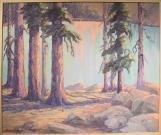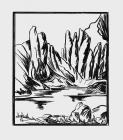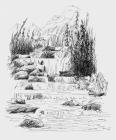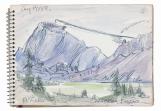1
Vaughan Grayson wrote Adventures of an Artist in the Canadian Rockies over an extended period during the 1950's and early 1960's. The book is a sort of journal of several different excursions into the Rocky Mountains. It contains relations of her own personal experiences on these journeys, but its primary focus seems to be depicting the beauty of the Rockies as seen through her eyes. At the time she wrote the book, that area was very familiar to her, and she had committed its landscapes to canvas many times. The book is a celebration of the Canadian Rockies, with each of its 19 chapters focusing on a different locale. Each chapter begins with a quotation from a poetry or prose work, reflecting Grayson's early education.
Adventures of an Artist in the Canadian Rockies was completed in 1962 and was submitted for publication to MacMillan Co. of Canada. It was refused, and Vaughan Grayson never sent it to another publisher. The manuscript sat untouched until her death, when it was left to her nephew, David Grayson.
When he donated a collection of his aunt's artwork to the Moose Jaw Museum & Art Gallery, he mentioned that he had this unpublished manuscript. He sent it to the Museum's curator, Heather Smith, who finally succeeded in getting it published. The Museum published the book as Vaughan Grayson: Adventures of an Artist in the Canadian Rockies in 2004, accompanying an exhibition of the same name.
All the following text is excerpted from this book, in the same language as was written by Vaughan Grayson approximately 50 years ago.
"Because I have spent many pleasant holidays in the environs of the Canadian Rockies, and find it is a source of ever increasing joy with the passing of the years."
2
Lake Louise
Circa 1920
Banff Park, AB
 Credits:
Credits:
Moose Jaw Museum & Art Gallery
3
"Many happy days were spent around Lake Louise. With each dawn, one was eager to be at the lake and desirous of spending as many hours as possible there, fishing, boating, hiking, painting or just dreaming; for no matter in which direction one looks there is beauty and grandeur to cast a spell and set one thinking of the storied past. Who was the first to thrill to the depths of his being when first seeing Lake Louise? Were they Indians, trappers, hunters, guides, explorers, mountaineers, geologists, who first came upon the lake, wrestling it from grizzlies and other denizens of the mountain and forest? Long before this train of adventurers, there was the time of the dawn, when, with the shrinking of the earth, Mother Nature gave birth with gigantic earth tremors, and thrust up the young, unweathered mountains. Then came the ice age, the last evidence of which are the magnificent ice fields and lakes which are here today."
4
Mirror Lake
Circa 1944
Banff Park, AB
 Credits:
Credits:
Moose Jaw Museum & Art Gallery
5
"Then too, there is that exceptional view of Lake Louise, Mirror Lake and Lake Agnes, all visible at the same time. But the lovely little glimpses one sees through the trees of lake and forest are more intimate and appealing, and too, one is assailed by the fragrance of the balsam and fir. Everywhere on the pathway the lively little chipmunks make friendly advances, greedy for the peanuts or chocolate which one may offer.
Mirror Lake is circular in shape and is in the heart of an evergreen forest of fragrant balsam, silent and beautiful. The last rays of the late afternoon sun casting salmon-rose colored reflections from the rocks and shale on the emerald green of the motionless water is a picture long to remember. In the late afternoon on my return to Lake Louise, I lingered long enough at Mirror Lake to make a sketch of this delightful bit of pattern and color, which expressed so well the peaceful, quiet beauty of those unexpected places in the mountains. So, leaning against a stately balsam, I opened my sketch box and recorded this exquisite moment of beauty."
6
Lake Agnes
1950-60
Banff Park, AB
 Credits:
Credits:
Moose Jaw Museum & Art Gallery
7
"Further up the ever steeper trail, one climbs on toward the rugged sky line, first arriving at the falls below Lake Agnes. ... Here the climber rests to drink in the beauty of this somewhat eerie place. Lake Agnes is a fine example of a 'cirque', an arm chair valley in the high mountains which overhang main valleys. The cliffs are vertical on all sides, except the front, which opens towards the valley below, affording a fine drop of steep rock face of 300 feet over which water falls from the lake above, and in so doing, throbs a gay cadence from the lake above. It is really a deserted basin of a cliff glacier."
8
Golden Larch
28 May 1963
Larch Valley, AB
 Credits:
Credits:
Moose Jaw Museum & Art Gallery
9
"The rugged mountain path west of the lake wound up for some distance to an upper meadow called Larch Valley. The morning was cool and slightly misty - but invigorating - and the air was fragrant with the perfume of the grasses, flowers, and larch trees. The larch trees were particularly fine in their feathery leafage like lovely fresh green plumes. As we made the ascent we were enthralled with the magnificent view of Moraine Lake below and the tremendous wall of rock which extended high above the lake and still higher above the Larch Valley. It was, of course, the mountains of the Valley of the Ten Peaks."
10
Annet Lake and Edith Lake
15 August 1959
Jasper Park, AB
 Credits:
Credits:
Moose Jaw Museum & Art Gallery
11
"It is quite a wide valley, bordered by sinister looking mountains, to the right Sheol, meaning Hell, sombre and reddish, and the shadowy blue of Mount Temple to the left. A noisy, furiously rushing creek, over which we crossed and recrossed many times on log foot-bridges, hurried its spirited way to the Bow Valley far below. We passed through some very fine tall cedars, which formed a beautiful cathedral. Presently a branching path marked 'Annett Lake' lured us off our course, and we found ourselves at Annett Lake for lunch. The trail led abruptly up and directly towards Temple Mountain, although we could not see the mountain for the deep forest. Being thirsty, we scouted around through the somewhat dank forest, over fallen trees and through masses of fern and moss, for the creek we knew must be somewhere near. When the water was reached, a hidden rill was discovered splashing merrily through the rocks and ferns, where 'the netted sunbeams dance.' We satisfied our thirst and discussed the pros and cons of lunching there, or pushing on to Annett Lake. We decided to move on. It would be another lake in the bag. What a surprise awaited us! An abrupt rock face with a falls, and just above the splashing water was the radiant ultramarine blue water of Annett Lake, bathed in sunshine and ruffled by a cold, stiff breeze. Rising directly above the lake was the desolate and formidable rocky facade of Temple Mountain."
12
Giant Steps
Circa 1930
Paradise Valley, AB
 Credits:
Credits:
Moose Jaw Museum & Art Gallery
13
"On the main trail again, we hastened on towards the 'Horseshoe Glacier' and the Giant Steps, the final goal of our hike in Paradise Valley. Presently we saw a somewhat dishevelled man hurrying along towards us. I approached him to ask if we were anywhere near the Giant Steps. In a somewhat bewildered way he replied, 'The Giant Steps? Then this must be Paradise Valley.' 'Indeed it is, we have been travelling all morning from the Moraine Lake road.' He was lost. Since five in the morning he had been struggling at a break neck pace over the various mountain trails and passes, trying to find his way back to Lake Louise. He had had no lunch, so we offered him our oranges. After directing him as well as we could, we continued on our way to the head of the valley, which opened out into a great amphitheatre of mountain meadowland, surmounted by a massive shell-shaped mountain, Hungabee, which encloses the Horseshoe Glacier, an ice field of tremendous proportions. Here, too, are the Giant Steps, leading up to the ice and over, which plays a very beautiful mountain water fall."
14
Bow Lake
14 August 1959
Banff Park, AB
 Credits:
Credits:
Moose Jaw Museum & Art Gallery






